Barkleyanthus salicifolius
Phytologia 27: 407. 1974.
Illustrated
Basionym: Cineraria salicifolia Kunth in A. von Humboldt et al., Nov. Gen. Sp. 4(fol.): 148. 1818; 4(qto.): 188. 1820
Synonyms: Senecio salignus de Candolle
Stems abundantly branched, arching distally. Leaves tapering to weakly defined petioles; blades 3–10 (–15) × 0.5–1.5 cm. Heads (3–) 8–16 in each array, arrays usually clustered. Phyllaries 4–6 (–8) mm, tips green, obtuse. Ray corollas 8–12+ mm. Disc corollas (5–) 7–8+ mm. Cypselae (1.5–) 2–3 mm; pappi 5–6+ mm. 2n = 60.
Phenology: Flowering year-round, mostly spring.
Habitat: Open, rocky, disturbed sites
Elevation: 700–1500 m
Distribution

Ariz., N.Mex., Tex., Mexico, Central America
Discussion
Barkleyanthus salicifolius is abundant and semiweedy through much of Mexico and northern Central America; it barely enters the flora area. The flowering heads are attractive and the species is sometimes cultivated.
Selected References
None.
Lower Taxa
None.
... more about "Barkleyanthus salicifolius"
introrse +
connate +
dilated-truncate +
papillate +
deltate;lanceolate or penicillate +
scarious +
hispidulous +
papillate +
continuous +
decurrent +
3-nerved +
lanceolate;lance-linear +
winged;nerved;ribbed +
stigmatic +
barbellulate +
80;120 +
white +
persistent +
60;80 +
absent +
not 2-lipped +
yellow +
5-nerved +
2mm;3mm +
staminate +
straight +
glabrous +
distinct +
proximal +
1;5 +
bisexual +
dispersed +
equaling +
singly +
clustered +
indeterminate +
8;16 +
Present +
surrounding +
campanulate;weakly turbinate +
petiolate +
alternate +
cauline +
tapering +
lance-linear +
recurved +
scarious +
2-carpellate +
inferior +
attached +
anatropous +
persistent +
tough +
thick +
absent +
connate +
defined +
persistent +
distinct +
herbaceous +
falling +
erect +
equal +
Phytologia +
1974 +
pistillate +
absent +
fertile +
epaleate +
foveolate +
flat;convex +
fibrous +
exalbuminous +
modifed +
Illustrated +
alternate +
branched +
arching +
continuous +
2-branched +
glabrous +
papillate +
Barkleyanthus salicifolius +
Barkleyanthus +
species +
equaling +
green +
longer +
